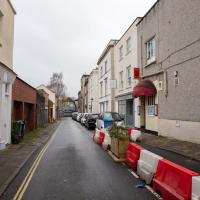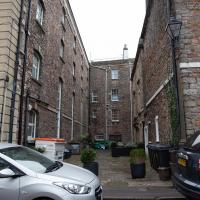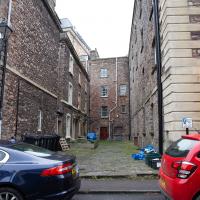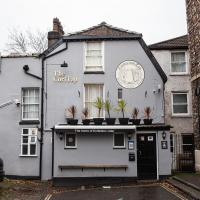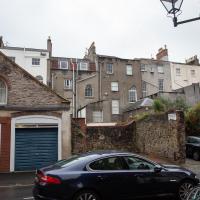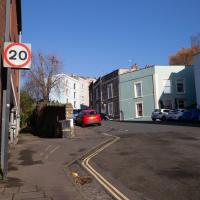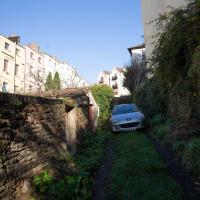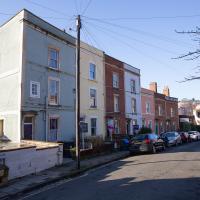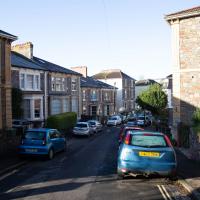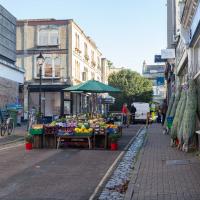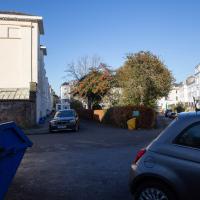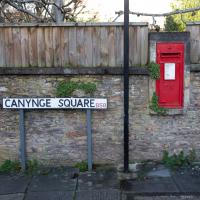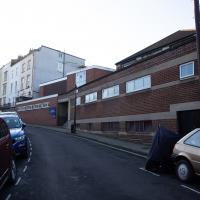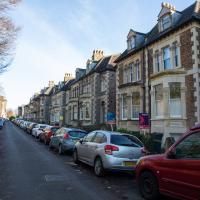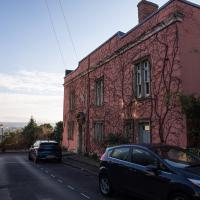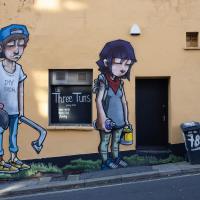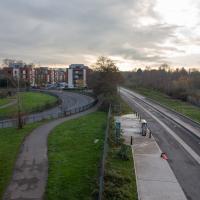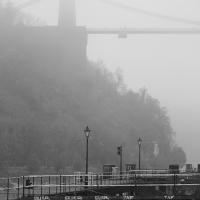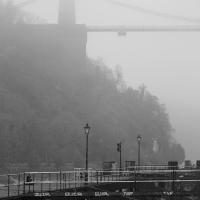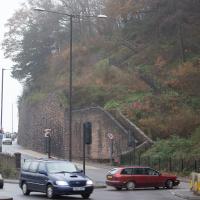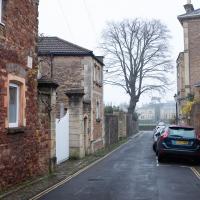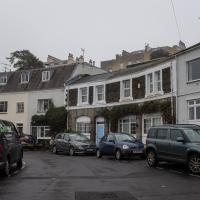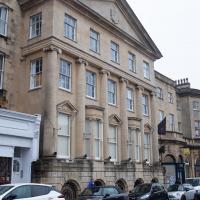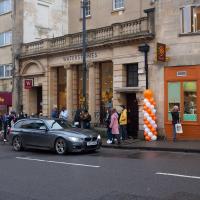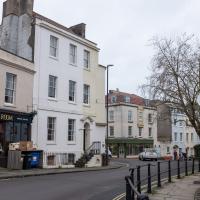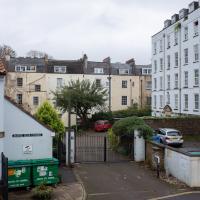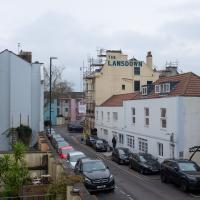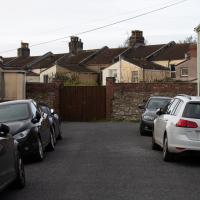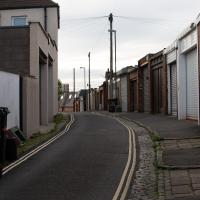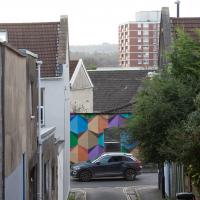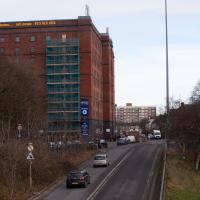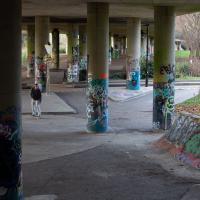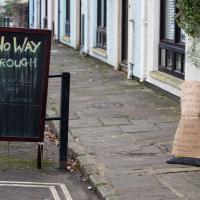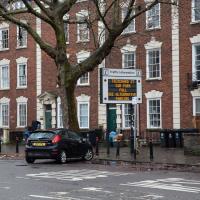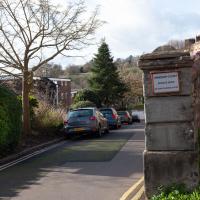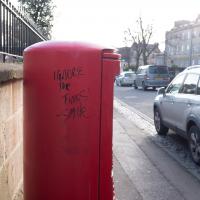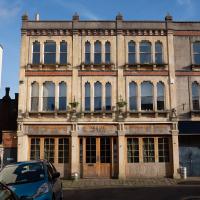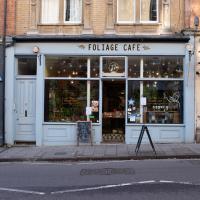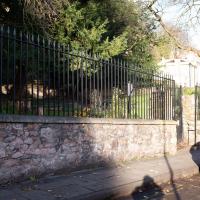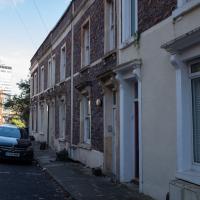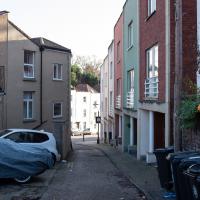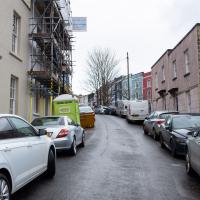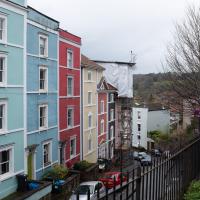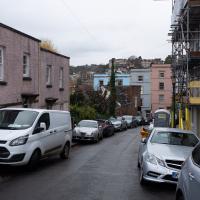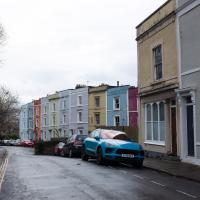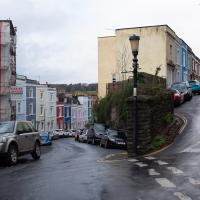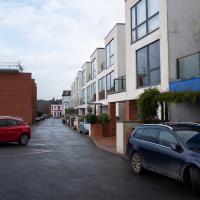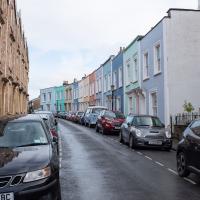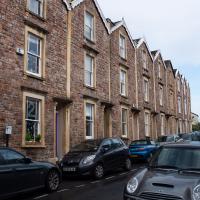Tagged: infrastructure
Up for the flu jab
21 Nov 2020
A trip up the hill to get my winter flu jab. I'm not sure I really needed it this year, what with avoiding Covid—I haven't had so much as a sniffle in more than a year—but seeing as they offered... Instead of the doctor's surgery on Pembroke Road, they'd taken over Christ Church, presumably to give more room and ventilation for the necessary social distancing at the moment. As usual, it was their typically efficient operation, and I was in and out in about three minutes.
On the way there and back I snapped as much as I could, but I wanted to be home in time for the first online Times Crossword Championship. As it turned out, I needn't have bothered, as the technology at the Times couldn't keep up with the demand from competitors, and their system just collapsed under the weight of page-views. They tried again the day after, and it collapsed just as badly. Maybe next year...
This wander is split into two parts, as I turned my tech off to go into Christ Church for my jab. The walk home can be found over here.
Although it looks like the side of the kind of flats you see everywhere in Clifton Village, the building to the left is actually the Christchurch Recording Studios. Among other artists who've used the studios, two of Massive Attack's number one albums were recorded here, according to this article that sadly but inevitably seems to suggest that the building might be converted into luxury flats soon.
It was originally fitted out as a drama and recording studio by the BBC in the 1980s.
I really like the random scattering of windows on the backs of Bristol's houses, especially the arched ones here.
Avoiding the Accounts
26 Nov 2020
I took the day off my day job to do my accounts—or at least do enough bookkeeping to send them to my accountant. I hate doing the books. I woke up late, tired and with a headache and decided to bunk off for a walk around Cliftonwood, Clifton Village and Clifton instead, taking in a couple of good coffees along the way. Thanks, Foliage Café, and Twelve for the flat whites.
The impressive building on The Mall that now houses the Clifton Club was originally built as a hotel and assembly rooms. I was looking up the history the other day in an attempt to track down the assembly rooms the eponymous heroine visited in Fanny Burney's novel Evelina, but Evelina was published in 1778 and this building wasn't built until 1805, from what I can work out. (It definitely wasn't the Victoria Rooms, either, for fairly obvious resons, given the name!)
The Long Lunchtime at the End of the World
27 Nov 2020
I took an extra-long break at lunchtime today as I'd taken the day off my normal day-job to do the accounts for my previous side-job, which is still generating paperwork, though not much in the way of money. This took me through some undiscovered bits of Cliftonwood, including Worlds End Lane, which unexpectedly leads to White Hart Steps. That's certainly not where I expected the end of the world to lead to...
I came up here drunk one night, searching for a shortcut home from somewhere around the Triangle. At least this time I was reasonably sure I'd not get out of the far end here.
A long ramble, starting with trying to find the Hot Well of Hotwells and leading up the side of the Avon Gorge to the Downs and then through Clifton for coffee.
When you take two virtually identical pictures but don't want to get rid of either one.
I recently learned—after seeing reference to someone being "mewed up" in EH Young's Chatterton Square (which is set in nearby Canynge Square)—that "mew" is an old word for "moult". And that hawks used to be confined in cages called "mews" when they were moulting. That's where The Kings Mews in Charing Cross first got its name; it was where the royal hawks were confined during their moulting. Later The Kings Mews was converted to stabling, and became the place where the King's carriages were kept, and the word "mews" spread from there and began a new life a word for a road full of coachhouses, or later, garages, turning as it did from a plural to a singular. So we now have the words "mew", "mews", and "mewses", each more plural than the last!
It's very nice in there. I will never be wealthy enough to be asked to join, which I understand it the only qualification I don't fulfill, being white, male and old. Actually, I tell a lie; in 2006 they voted to allow women to join, after only 188 years of prior existence
The old WHS is no longer standing; the entire block has just been demolished as I write this, on 14 Feb 2021, including this wall, which was standing up until some time last week. I wonder what they did with the metal cabinet, which I've always thought of as a somewhat disreputable TARDIS.
Speaking of queueing, here's the queue for the newly-opened Eat a Pitta branch in the shop Boston Tea Party used to occupy on the corner of Regent Street and Princess Victoria Street. It had attracted the attention of the police more than once already, apparently, as not much social distancing seemed to be happening.
The queue for Eat a Pitta is always very similar in St Nicholas Market of a lunchime. I've never eaten there myself.
Ten O'Clock Shop and Can't Dance Coffee
30 Nov 2020
I had to return a faulty AirPod Pro to Apple (there's a first-world problem!) so I just took a quick trip up the hill to the nearest UPS drop-off point, The Ten O'Clock Shop, which is famously open until 11pm. Unfortunately it's a fairly cramped little place and neither of the staff were wearing masks, so I made it a very quick drop indeed and got out of there as quickly as I could.
I grabbed a quick coffee from Can't Dance, a stall that's—as of yesterday—in a tiny converted cargo container on the edge of Victoria Square; up until this week they were running from a little trike parked in the same place. Hopefully the new premises will let them see out the winter without worrying quite so much about the weather.
I tried to fit in a few extra streets from the surrounding area on my there and back, but that was basically my wander today: a quick little shopping trip.
Mint on the left, Rosemarino on the corner ahead, where the old York Cafe used to be, serving a full English for £1, back in the day.
Fruitless Coffee Excursion
01 Dec 2020
Unfortunately by the time I got to Greville Smyth Park I was already about halfway through my lunch-hour, and the queue was too long to wait to actually get a coffee. Is that a fruitless excursion? Presumably a coffee bean is technically a fruit...
This kind of vague musing was sadly overshadowed by my delay at Ashton Avenue Bridge on the way back, where someone—hopefully still a someone, rather than a body—was being stretchered up the bank of the river, presumably having just been rescued from the water. As I made my way home the long way around, avoiding the cordoned-off area at the back of the CREATE centre and its car park, I saw an ambulance haring across the Plimsoll Bridge, siren running, presumably on its way to the BRI. I'd like to think that was a good sign.
Nothing New
02 Dec 2020
This may be the very first time I've gone for a One Mile Matt wander and not actually gone down any new roads, trod any new steps. I just wanted a coffee, frankly, so I went the same old way to Imagine That in the marina and back again.
Cliftonwood and a Secret Garden
03 Dec 2020
I love the isolation of Cliftonwood -- the geography of it, with its solid boundary of Clifton Vale to the west and Jacob's Wells Road to the east mean that you tend not to be in Cliftonwood unless you've got a reason to be there. It's not a cut-through to anywhere, at least not from side-to-side, and you can only really exit to the south on foot.
I sense that I'd be happy living in Cliftonwood -- like my bit of Hotwells, it's a quiet little area with a sort of quirky feel to it. Plus it contributes the colourful houses that are the backdrop of about half of all Bristol postcards ever made :)
I found the "secret" garden especially interesting, just for the fact that it really does feel quite secret, despite the obvious name on the gate. I've lived a half-mile from it for twenty years and I don't think I've ever noticed it before, despite exploring the area a few times.
I got curious about Bioinduction's sign down on the Hotwell Road once. According to the company's website theire mission is to "develop a precisely targetted brain pacemaker that offers new hope for the millions of sufferers... To revolutionise the treatment of cerebrovascular and neurodegenerative diseases where there is no effective drug therapy available today."
Apparently Gnodal "was a computer networking company headquartered in Bristol, UK. The company designed and sold network switches for datacenter, high-performance computing and high-frequency trading environments"
Strangers' Burial Ground
04 Dec 2020
I tried to find the Strangers' Burial Ground the last time was up in Clifton, but I'd not realised that Lower Clifton Hill continues further on after the turning with Constitution Hill. Sadly it was chained shut, but it still looks beautifully-maintained, perhaps by the same man referenced by this story from John Hodgson, which helped me find it. Apparently Thomas Beddoes is buried here.
Although, given the sign, perhaps I shouldn't have. But I didn't think they'd object terribly. I've actively interested in living here; a couple of flats have popped up on the market in recent times and the views are amazing.
Only been in a couple of times over the years. I like the way it's got a back entrace from the Arcade, and I seem to remember the beer was varied and well-kept.
More Cliftonwood
05 Dec 2020
Back to Cliftonwood for a wander that included some of the belle views of Bellevue Crescent and other bits of the easternmost part. Highlights included watching someone bump-starting an elderly Nissan Micra in the narrow confines of Bellevue Crescent.
I looked back on the old maps, and found “School Ruins” on the 1947-1965 OS maps layer, then just “School” on a few earlier maps, but then, finally, the 1874 Ashmead map told me enough to track it down: “Clifton National School”.
According to the Clifton and Hotwells Character Appraisal:
In 1835, the Clifton National School was built on the terrace above Hotwell Road and the Clifton Poor-Law Union workhouse on the lower terrace, becoming Clifton Industrial School in 1849; the same year, Hotwell Road was widened. A Training Institute for Females and Domestic Servants in Clifton Wood also appeared in this area by 1860 and by 1901, 53 trades were recorded between Dowry Square to Anchor Road, including 23 pubs…
…Clifton largely escaped widespread destruction during the blitz, though… a bomb also largely destroyed the Clifton National School and Mardyke House School. The lack of bomb-proof shelters in Clifton led to the Clifton Rocks Railway to be used as shelter, which was prepared for occupation in 1940. Throughout the bombing up to 200 spent the night there.
